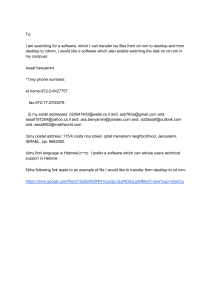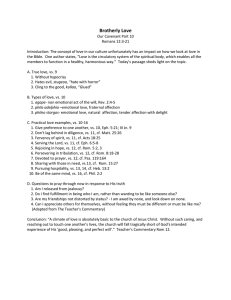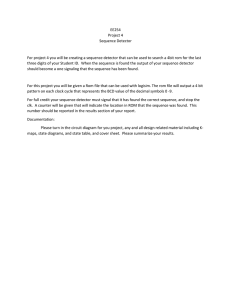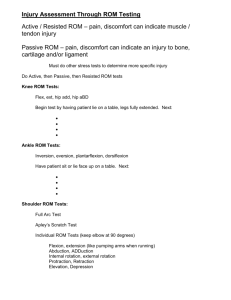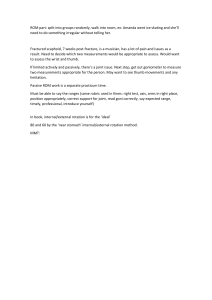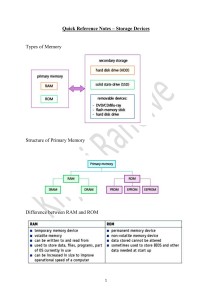13. Strength and Conditioning (Presentation) Author Scottish Gymnastics
advertisement
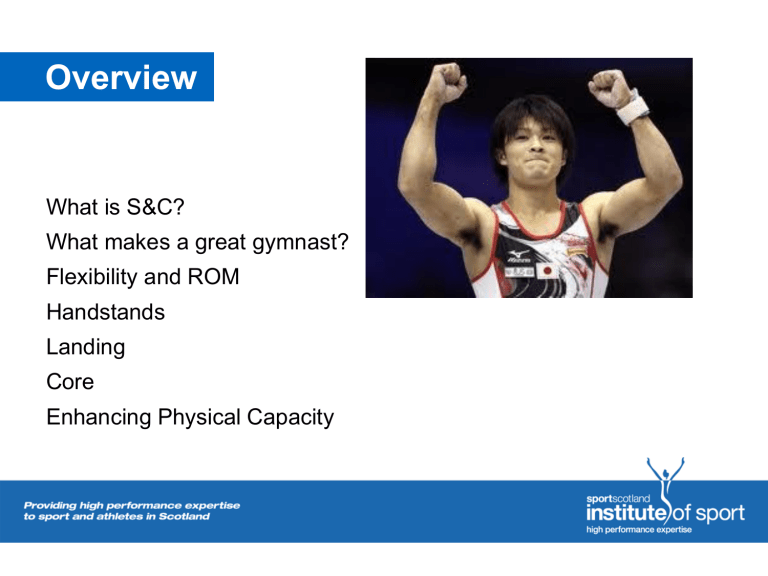
Overview What is S&C? What makes a great gymnast? Flexibility and ROM Handstands Landing Core Enhancing Physical Capacity What is S&C? A specialised area of sports science focused on optimising physical preparation for sports performance Involves developing strength, speed, power, endurance, flexibility, specific to the sport and athlete Reducing injury risk It is NOT Body building Demands of Gymnastics Aesthetic sport involving multi muscle, multi joint movements. Large ROM in most joints, strength required through full ROM. Time in the air is important and this is increased by improving strength and power of upper and lower body. Improvement in these areas allows time for more somersaults and/or twists and landing time. Large upper body strength demand (4/6 apparatus) PCr and LA energy systems predominate, recovery aerobic.(FX 70s, V~4s, Rest~30s) Typically large training time required (+30hrs per week) What Physical Characteristics Make a Great Gymnast? Flexibility Strength Speed Muscular Endurance Skill (Jemni 2011; Arkaev and Suchilin (2004) Flexibility Must have good ROM across most joints How much flexibility do we need? Need to know what you are stretching and why? Are our stretches appropriate? Hip ROM Tight Tight hip flexor? Hamstring? Tight Glutes? If you know what is restricting the movement you can target it directly Ankles and Wrists Do we need good ROM in ankle and wrist? Need ankle stability but it is also important to have good ROM to prevent injury Shoulders Full ROM is essential because it will allow improved performance and more economical gymnastics It will allow correct shapes to be achieved reducing execution errors Reduce injury risk Shoulders Assessing ROM Hip Flexors Gymnast to lie on edge of box/ horse Pull knee to chest keeping lower back in contact with box/ horse Relax opposite leg Simple grading Red = knee above horizontal Amber = knee at horizontal Green = knee below horizontal Assessing ROM Ankles Measure distance from the wall that the gymnast can touch with their heel flat Hips square to wall Simple grading Red =0-5cm Amber = 6-9cm Green = 10+cm Assessing ROM Shoulders Sit with gymnasts back against a wall Lift arms as high as possible maintaining contact with the wall Simple grading Red = No contact with wall Amber = Wrist to touch wall Green = Wrist and elbows to touch wall Practical ..\Women's Gymnastics\Programmes\WAG Stretches & Release 2014.docx ..\Men's Gymnastics\Programmes\Release & Mobility.docx Handstands Improve shoulder ROM and improve handstand in many gymnasts You all know the progressions Must reinforce correct position at all times no matter the location (Floor, PBar, Rings) Landing Determined by motor control and the ability to cope with load (Marinsek 2011) The amount of force required to be absorbed during take off AND landings can be in excess of 14X Body Weight It is essential that correct landing position is taught and reinforced Uchimura Landing Focus should not just be on the stoi Landing Landing Drill Ideas 1. Show correct landing position 2. Land from box 3. Single leg landing from box (knee height) 4. Hop and stick 5. Somersault to land The “Core” What is the “core?” The “Core” How do you train it? Leg lifts, sit ups, dish/ arch etc Are our exercises working what we want them to work? Is posture a focus? It should be! Physical Capacity Do you really need to do anything fancy? Do more gymnastics Decrease rest time Increase training density (how much work in a given time) If routine lasts 30s does going for a 1hr jog make sense? Summary: Maintain ROM in all joints All areas of performance need coached Reinforce correct landing position Question what you are doing Any Questions?
